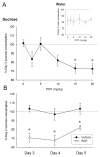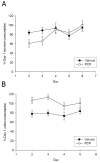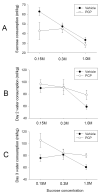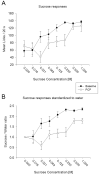Behavioral processes mediating phencyclidine-induced decreases in voluntary sucrose consumption
- PMID: 17904209
- PMCID: PMC2266588
- DOI: 10.1016/j.pbb.2007.08.011
Behavioral processes mediating phencyclidine-induced decreases in voluntary sucrose consumption
Abstract
Prior exposure to phencyclidine (PCP) has been shown to decrease voluntary sucrose consumption in rats, which may indicate reduced reward function. To further characterize the effects of PCP on sucrose consumption, we examined the dose-response relationship between PCP and sucrose consumption, the longevity of the effect, the effects of repeated injections of PCP, variation of the PCP effect across sucrose concentrations, and the effects of PCP on gustatory hedonic responses. A single injection of PCP (2.5-20 mg/kg) dose-dependently suppressed sucrose consumption 20 h post-injection, with significant decreases after 15 and 20 mg/kg PCP. These decreases were sustained three days following withdrawal from PCP. Repeated injections of PCP (7.5 mg/kg bid for 7 days) decreased sucrose consumption 20 h after withdrawal, which returned to baseline on the second day. A single injection of PCP (15 mg/kg) suppressed 0.15 M sucrose more than 1 M sucrose consumption, with no effect on 0.3 M sucrose, suggesting that PCP suppressed intake of moderately rewarding taste stimuli. Finally, a single injection of PCP (15 mg/kg) suppressed brief access (20 s) licking for the majority of concentrations of sucrose solutions offered (0.031 M, 0.062 M, 0.125 M, 0.25 M, 0.5 M, and 1.0 M), while it had no effect on licking for 0.016 M sucrose, water, or for bitter quinine hydrochloride solutions (range: 0.94 mM-30 mM), suggesting that the PCP effect is specific to palatable taste stimuli without disruption of sensitivity to taste quality or intensity. We conclude that PCP produces moderate anhedonia as reflected through a specific decrease in the sustained consumption of moderately palatable sucrose solutions.
Figures






References
-
- Allen RM, Young SJ. Phencyclidine-induced psychosis. Am J Psychiatry. 1978;135(9):1081–4. - PubMed
-
- Baird JP, Rios C, Gray NE, Walsh CE, Fischer SG, Pecora AL. Effects of melanin-concentrating hormone on licking microstructure and brief-access taste responses. Am J Physiol Regul Integr Comp Physiol. 2006;291(5):R1265–74. - PubMed
-
- Baird JP, John SJ, Nguyen EA. Temporal and qualitative dynamics of conditioned taste aversion processing: combined generalization testing and licking microstructure analysis. Behav Neurosci. 2005;119(4):983–1003. - PubMed
-
- Bakker CB, Amini FB. Observations on the psychotomimetic effects of Sernyl. Compr Psychiatry. 1961;2:269–80. - PubMed
-
- Berridge KC, Robinson TE. What is the role of dopamine in reward: hedonic impact, reward learning, or incentive salience? Brain Res Brain Res Rev. 1998;28(3):309–69. - PubMed
Publication types
MeSH terms
Substances
Grants and funding
LinkOut - more resources
Full Text Sources

